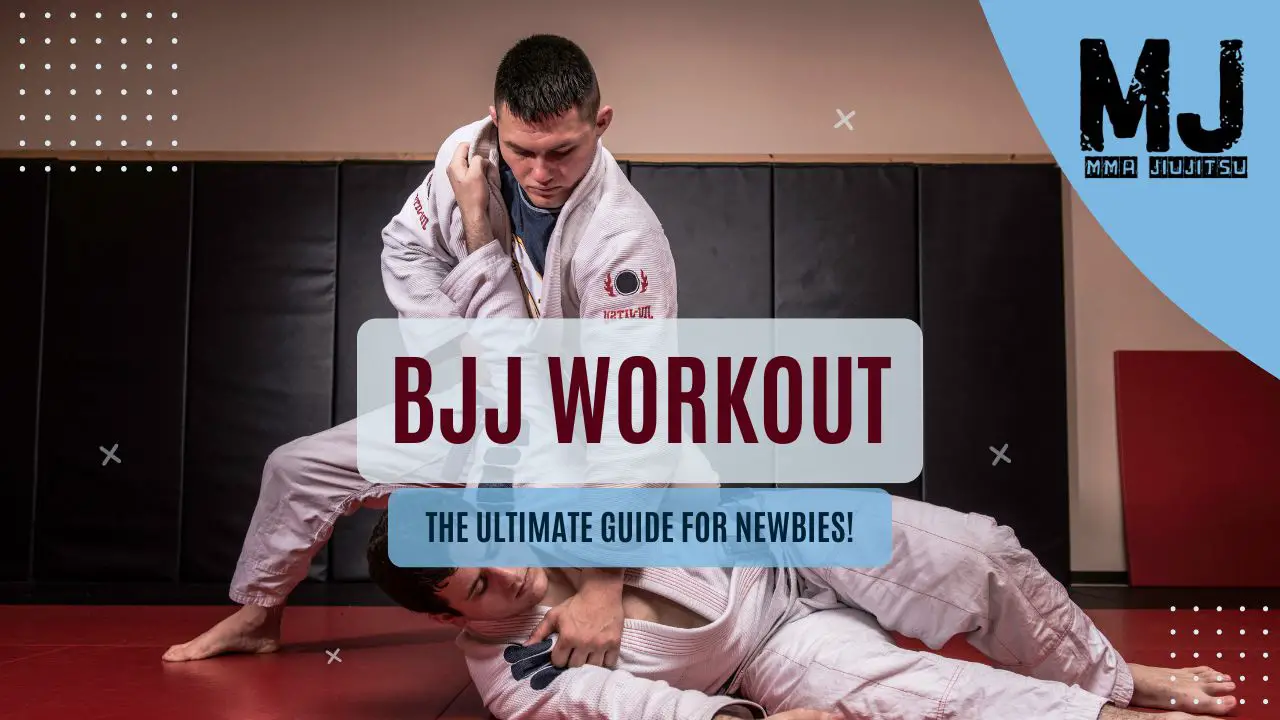BJJ is a ground-based martial art that prioritizes leverage, submissions, and control over brute strength. It is popular in MMA and self-defense.
This guide is for beginners. You’ll learn basics, workouts, and progress in the art.
Significance of BJJ Workouts
Workouts are essential to Brazilian Jiu-Jitsu (BJJ) training.
They provide various benefits, such as strength, body coordination, flexibility, and stamina building.
Beginners, in particular, need to focus on workouts to build their endurance and strength.
Although BJJ’s rolling and drilling sessions offer a complete body workout, incorporating exercises can intensify the training.
Components of a BJJ Workout for Beginners
For beginners in Brazilian Jiu-Jitsu, start each session with a thorough warm-up.
This is essential to prevent injuries and prepare the body for intense physical activity.
Dynamic stretches that imitate the movements used in BJJ, including arm circles, leg swings, and hip openers, are highly recommended.
Foundational positions like the Guard, Mount, and Side Control are essential techniques every beginner should learn.
Indeed, core movements, like Shrimping (hip escape) and Bridging, are crucial in developing mobility on the ground.
In addition, it is recommended to complement BJJ drills with strength and conditioning exercises, such as push-ups, squats, and core strengthening.
These exercises will help build the physical attributes necessary to perform well in training.
BJJ Workout Programs for Beginners
Following are listed some of the workouts that work as a wonder for beginners:
Kettlebell Turkish Get up
Kettlebell Turkish get-ups work the entire body, especially your glutes and calves. They also enhance your shoulder stability so that you can easily initiate takedowns.
| Sets | Reps | Rest |
| 2-3 | 10-12 | 1 min |
How to perform kettlebell Turkish get-ups:
- Lie straight on the mat and lift the kettlebell with your right hand.
- With the help of your left hand, sit on the mat while lifting the kettlebell at all times.
- Shift your shoulders and straighten them while standing.
- After getting into the standing position, transition back into the initial position.
Pull-ups
Pull-ups are an excellent exercise for your upper body. They strengthen your forearms and chest muscles.
Excellent shoulder strength will aid you in escaping your opponent’s techniques and applying your own quickly.
| Sets | Reps | Rest |
| 2-3 | 10-15 | 1 min |
How to perform pull-ups:
- Stand before a bar and grab it with a wide shoulder grip.
- Lift your body and bring the bar up to your chest.
- You can also perform single arm-pull-ups or weighted pull-ups to intensify the exercise.
Kettlebell Swings
Kettlebell swings are significant for cardio.
They work on your whole body muscles and provide a greater grip strength.
Grip strength is a necessary part of Gi BJJ.
| Sets | Reps | Rest |
| 2-3 | 12-15 | 45 sec |
How to perform kettlebell swings:
- Start from a deadlift position, so the kettlebell must be between your feet.
- Pull your hands upward and keep your shoulders in.
- Lift the kettlebell from the ground and move it to and fro while initially building a small momentum.
- Push your hips back and then thrust them forward as the kettlebell moves.
- Complete the desired sets and reps and get a perfectly toned and strengthened body for BJJ.
Chin-ups
Chin-ups work on the strength and conditioning of your forearms, biceps, and triceps.
The latissimus dorsi muscles of your back are also engaged in exercise.
| Sets | Reps | Rest |
| 1-2 | 10-12 | 60 sec |
How to perform kettlebell swings:
- Hold the bar with an underhand grip.
- Keep your body straight and pull yourself to the point where your chin is up with the bar.
- Exhale at the highest point of the exercise and inhale when close to the ground.
Romanian Deadlifts
Romanian deadlifts are the perfect exercise to strengthen your posterior chain muscles for BJJ.
These exercises are more intense than simple deadlifts. The difference arises in the posture and the way both are performed.
| Sets | Reps | Rest |
| 2-3 | 10-12 | 1 min |
How to perform Romanian deadlifts:
- Step up to the bar so that your legs are close to it.
- Keep your legs shoulder width apart, and grab the barbell with an overhand grip.
- Lift the bar to the deadliest position, then bring it up to your hips.
- Bend your knees slightly as you reach the lowest position and thrust your hips back.
- You will experience a stretch in your hamstrings. Complete the reps and obtain a conditioned body for BJJ.
Barbell Glute Bridge
Barbell glute bridge works on glutes and hamstrings, especially hip flexors.
It is slightly different from hip thrusts, as in hip thrusts exercise!
Practitioners take support from a bench, while in the barbell glute bridge, practitioners have to lie straight on the mat.
| Sets | Reps | Rest |
| 2-3 | 10-12 | 50 sec |
How to perform barbell glute bridges:
- Lie straight on the ground with your legs between the weighted barbell.
- The barbell must touch your thighs.
- Lift the barbell with the help of your hands and thighs.
- Your feet must be placed on the ground with bent knees.
- Complete the reps, and you will have a strong lower body.
Kicking Up
Kicking up is perfect for freeing yourself when your opponent constricts you.
You can grab your opponent’s arm from this position and transition to applying the armbar submission.
| Sets | Reps | Rest |
| 1-2 | 10-15 | 1 min |
How to perform kicking up drill exercise:
- Lie down on the ground and lift your feet above the ground.
- Bend your knees slightly, raise your legs to the top in the air, and slowly lower them, but don’t touch the ground.
- Complete the reps, and you will have completed a drill exercise.
The Bear Crawl
The bear crawl focuses on your speed and agility.
BJJ is a ground grappling sport where practitioners must be vigilant and fast to escape submissions and takedowns.
| Sets | Reps | Rest |
| 2-3 | 10-15 | 30 sec |
How to perform the bear crawl:
- Appear on the ground in a dog style where all four limbs touch the ground.
- Move in all directions, like forming a square.
- Complete the reps and become ready to pound on your opponent.
Common Beginner Mistakes and How to Avoid Them

Beginners in any physical activity often need to pay more attention to sufficient recovery, which can lead to burnout or injuries.
Paying attention to your body’s signals and ensuring proper rest and recovery are incorporated into your routine is crucial.
Another common mistake is getting too caught up in complex techniques instead of mastering the fundamentals.
It is essential to seek regular feedback from instructors and experienced practitioners.
This will ensure that you are practicing with the correct form and a comprehensive understanding of techniques.
Resources for Further Learning

While the dojo is your primary learning space, expanding your knowledge beyond its walls is equally important.
As a beginner, you have a wealth of learning resources, such as instructional books, online tutorials, and video analyses of matches.
These resources offer additional perspectives and techniques to enhance your on-the-job training significantly.
Remember, the choice of a supportive and well-structured dojo is crucial!
Look for a place that fosters a positive learning environment and offers classes that progressively enhance your skills, empowering you to take your martial arts journey to new heights.
Conclusion
Brazilian jiu-jitsu is a type of submission grappling martial art that uses dominant techniques to emerge victorious.
BJJ workouts are crucial for building strength and conditioning.
They can also work wonders for beginners by developing speed, agility, flexibility, and improved body posture.
Some recommended workouts for beginners include kettlebell swings, Romanian deadlifts, pull-ups, chin-ups, and many more.



